Study on an Online Detection Method for Ground Water Quality and Instrument Design
Abstract
:1. Introduction
2. The Measurement Method and Principle of UV Spectrophotometry
2.1. The Measurement Principle of UV Spectrophotometry
2.2. Modeling and Verification of Linear Correlation
2.2.1. Modeling and Verification of the Linear Correlation of COD and TOC
2.2.2. Modeling and Verification of the Relation between COD Absorbance and Turbidity
3. Apparatus Design
3.1. System Structure
3.2. Detection Unit
3.3. Pipeline Unit
3.4. System Control Unit
4. Experiment
4.1. COD Detection Experiment
4.2. TOC Detection Experiment
4.3. NO3–N Detection Experiment
4.4. TURB Detection Experiment
5. Conclusions
- (1)
- The ground water quality parameters COD, TOC, NO3–N, and TURB were detected by the designed instrument and the detected relative errors were smaller than 5.0%, which proves that the proposed method of measuring multiple parameters of ground water quality based on UV spectrophotometry is feasible.
- (2)
- There is a certain correlation between COD and TOC in a stable water body. TOC content can therefore be obtained indirectly from detected COD through the linear correlation to COD; the experiment verified this.
- (3)
- The suspended substances in ground water have significant influences on the detection of COD, TOC, and NO3–N, so carrying out turbidity compensation analysis of the system when the COD, TOC, and NO3–N are detected is an essential step. For detecting the COD concentration of the ground water, the absorbance at the wavelength of 350 nm could be measured in advance and transferred to the absorbance at the wavelength of 254 nm based on Equation (3).
- (4)
- The wavelengths of 220 nm and 275 nm were used to measure the NO3–N concentration, because both organic matter and NO3–N have a strong absorption effect at 220 nm of ultraviolet light, but NO3–N does not have an absorption effect at 275 nm.
Author Contributions
Funding
Conflicts of Interest
References
- Kruawal, K.; Sacher, F.; Werner, A.; Müller, J.; Knepper, T.P. Chemical water quality in Thailand and its impacts on the drinking water production in Thailand. Sci. Total Environ. 2005, 340, 57–70. [Google Scholar] [CrossRef]
- Koraqi, H.; Luzha, I.; Termkolli, F. An assessment of the water quality and ecological status of SITNICA river, KOSOVO. Studia Univ. Babes Bolyai Chem. 2016, 61, 267–276. [Google Scholar]
- Shi, K.; Zhang, Y.; Xu, H.; Zhu, G.; Qin, B.; Huang, C.; Liu, X.; Zhou, Y.; Lv, H. Long-term satellite observations of microcystin concentrations in lake Taihu during cyanobacterial bloom periods. Environ. Sci. Technol. 2015, 49, 6448–6456. [Google Scholar] [CrossRef]
- Hsu, L.H.H.; Selvaganapathy, P.R.; Brash, J.; Fang, Q.; Xu, C.-Q.; Deen, M.J.; Chen, H. Development of a low-cost hemin-based dissolved oxygen sensor with anti-biofouling coating for water monitoring. IEEE Sens. J. 2014, 14, 3400–3407. [Google Scholar] [CrossRef]
- Davidsen, C.; Liu, S.X.; Mo, X.G.; Holm, P.E.; Trapp, S.; Rosbjerg, D.; Bauer-Gottwein, P. Hydroeconomic optimization of reservoir management under downstream water quality constraints. J. Hydrol. 2015, 529, 1679–1689. [Google Scholar] [CrossRef] [Green Version]
- Burchard-Levine, A.; Liu, S.; Vince, F.; Li, M.; Ostfeld, A. A hybrid evolutionary data driven model for river water quality early warning. J. Environ. Manag. 2014, 143, 8–16. [Google Scholar] [CrossRef] [PubMed]
- Liu, X.; Zhang, Y.; Shi, K.; Zhu, G.; Xu, H.; Zhu, M. Absorption and fluorescence properties of chromophoric dissolved organic matter: Implications for the monitoring of water quality in a large subtropical reservoir. Environ. Sci. Pollut. R. 2014, 21, 14078–14090. [Google Scholar] [CrossRef]
- Mantzafleri, N.; Psilovikos, A.; Blanta, A. Water quality monitoring and modeling in lake Kastoria, using GIS. assessment and management of pollution sources. Water Resour. Manag. 2009, 23, 3221–3254. [Google Scholar] [CrossRef]
- Campos, I.; Alcaniz, M.; Aguado, D.; Barat, R.; Ferrer, J.; Gil, L.; Marrakchi, M.; Martinez-Manez, R.; Soto, J.; Vivancos, J.L. A voltammetric electronic tongue as tool for water quality monitoring in wastewater treatment plants. Water Res. 2012, 46, 2605–2614. [Google Scholar] [CrossRef] [PubMed]
- Silva, C.R.; Conceicao, C.D.C.; Bonifacio, V.G.; Fatibello, F.O.; Teixeira, M.F.S. Determination of the chemical oxygen demand (COD) using a copper electrode: A clean alternative method. J. Solid State Electr. 2009, 13, 665–669. [Google Scholar] [CrossRef]
- Hsu, L.H.; Houqe, E.; Kruse, P.; Ravi Selvaganapathy, P. A carbon nanotube based resettable sensor for measuring free chlorine in drinking water. Appl. Phys. Lett. 2015, 106, 063102. [Google Scholar] [CrossRef]
- Hill, S.J.; Dawson, J.B.; Price, W.J.; Shuttler, I.L.; Tyson, J.F. Atomic spectrometry update? advances in atomic absorption and fluorescence spectrometry and related techniques. J. Anal. At. Spectrom. 2005, 15, 775–812. [Google Scholar]
- Hernandez, F.; Ibanez, M.; Portoles, T.; Cervera, M.I.; Sancho, J.V.; Lopez, F.J. Advancing towards universal screening for organic pollutants in waters. J. Hazard. Mater. 2015, 282, 86–95. [Google Scholar] [CrossRef] [Green Version]
- Galuszka, A.; Migaszewski, Z.M.; Namiesnik, J. Moving your laboratories to the field–advantages and limitations of the use of field portable instruments in environmental sample analysis. Environ. Res. 2015, 140, 593–603. [Google Scholar] [CrossRef] [PubMed]
- Sarraguca, M.C.; Paulo, A.; Alves, M.M.; Dias, A.M.A.; Lopes, J.A.; Ferreira, E.C. Quantitative monitoring of an activated sludge reactor using on-line UV-visible and near-infrared spectroscopy. Anal. Bioanal. Chem. 2009, 395, 1159–1166. [Google Scholar] [CrossRef] [Green Version]
- Beale, D.J.; Karpe, A.V.; Ahmed, W.; Cook, S.; Morrison, P.D.; Staley, C.; Sadowsky, M.J.; Palombo, E.A. A community multi-omics approach towards the assessment of surface water quality in an urban river system. Int. J. Environ. Res. Public Health 2017, 14, 303. [Google Scholar] [CrossRef]
- Moreno, M.G.; Leon, G.M.E.; Madrid, Y. Simultaneous determination of the size and concentration of AgNPs in water samples by UV-vis spectrophotometry and chemometrics tools. Talanta 2018, 188, 393–403. [Google Scholar] [CrossRef] [PubMed]
- Asheri, A.T.; Ezra, S.; Fishbain, B. Water characterization and early contamination detection in highly varying stochastic background water, based on Machine Learning methodology for processing real-time UV-Spectrophotometry. Water Res. 2019, 155, 333–342. [Google Scholar] [CrossRef]
- Qin, X.; Gao, F.; Chen, G. Wastewater quality monitoring system using sensor fusion and machine learning techniques. Water Res. 2012, 46, 1133–1144. [Google Scholar] [CrossRef]
- Kayaalp, N.; Ersahin, M.E.; Ozgun, H.; Koyuncu, I.; Kinaci, C. A new approach for chemical oxygen demand (COD) measurement at high salinity and low organic matter samples. Environ. Sci. Pollut. R. 2010, 17, 1547–1552. [Google Scholar] [CrossRef] [PubMed]
- Rene, E.R.; Saidutta, M.B. Prediction of water quality indices by regression analysis and artificial neural networks. Int. J. Environ. Res. 2008, 2, 183–188. [Google Scholar]
- Ishida, S.; Tsuchihara, T.; Imaizumi, M. Fluctuation of NO3–N in groundwater of the reservoir of the Sunagawa subsurface dam, Miyako island, Japan. Paddy Water Environ. 2006, 4, 101–110. [Google Scholar] [CrossRef]
- El-Fadel, M.; Bou-Zeid, E.; Chahine, W.; Alayli, B. Temporal variation of leachate quality from pre-sorted and baled municipal solid waste with high organic and moisture content. Waste Manag. 2002, 22, 269–282. [Google Scholar] [CrossRef]
- Chang, H. Spatial analysis of water quality trends in the Han river basin, south Korea. Water Res. 2008, 42, 3285–3304. [Google Scholar] [CrossRef]
- Liu, C.W.; Lin, K.H.; Kuo, Y.M. Application of factor analysis in the assessment of groundwater quality in a blackfoot disease area in taiwan. Sci. Total Environ. 2003, 313, 77–89. [Google Scholar] [CrossRef]
- Lee, S.; Ahn, K.H. Monitoring of COD as an organic indicator in waste water and treated effluent by fluorescence excitation-emission (FEEM) matrix characterization. Water Sci. Technol. 2004, 50, 57–63. [Google Scholar] [CrossRef]
- Shawaqfeh, A.T.; Momani, F.A.A. Photocatalytic treatment of water soluble pesticide by advanced oxidation technologies using UV light and solar energy. Sol. Energy 2010, 84, 1157–1165.24. [Google Scholar] [CrossRef]
- Beck, S.E.; Hull, N.M.; Poepping, C.; Linden, K.G. Wavelength dependent damage to adenoviral proteins across the germicidal UV spectrum. Environ. Sci. Technol. 2018, 52, 223–229. [Google Scholar] [CrossRef]
- Shi, K.; Zhang, Y.; Zhu, G.; Qin, B.; Pan, D. Deteriorating water clarity in shallow waters: Evidence from long term MODIS and in-situ observations. Int. J. Appl. Earth Obs. 2018, 68, 287–297. [Google Scholar] [CrossRef]
- Ikonen, J.; Kosse, P.; Ciszek, R.; Kolehmainen, M.; Miettinen, I.T. On-line detection of escherichia coli intrusion in a pilot-scale drinking water distribution system. J. Environ. Manag. 2017, 198, 384–392. [Google Scholar] [CrossRef]
- Schug, K.A.; Sawicki, I.; Carlton, D.D.; Fan, H.; Mcnair, H.M.; Nimmo, J.P.; Kroll, P.; Smuts, J.; Walsh, P.; Harrison, D. Vacuum ultraviolet detector for gas chromatography. Anal. Chem. 2014, 86, 8329–8335. [Google Scholar] [CrossRef]
- Finkenzeller, U.; Labs, D. Deuterium lamp as a uv continuum source from 160 nm to 320 nm for space applications. Appl. Opt. 1979, 18, 3938–3941. [Google Scholar] [CrossRef] [PubMed]
- Dubber, D.; Gray, N.F. Replacement of chemical oxygen demand (COD) with total organic carbon (TOC) for monitoring wastewater treatment performance to minimize disposal of toxic analytical waste. J. Environ. Sci. Health A 2010, 45, 1595–1600. [Google Scholar] [CrossRef]
- Chen, B.; Wu, H.; Li, S.F.Y. Development of variable pathlength UV–vis spectroscopy combined with partial-least-squares regression for wastewater chemical oxygen demand (COD) monitoring. Talanta 2014, 120, 325–330. [Google Scholar] [CrossRef] [PubMed]
- Sandford, R.C.; Exenberger, A.; Worsfold, P.J. Nitrogen cycling in natural waters using in situ, reagentless UV spectrophotometry with simultaneous determination of nitrate and nitrite. Environ. Sci. Technol. 2007, 41, 8420–8425. [Google Scholar] [CrossRef]


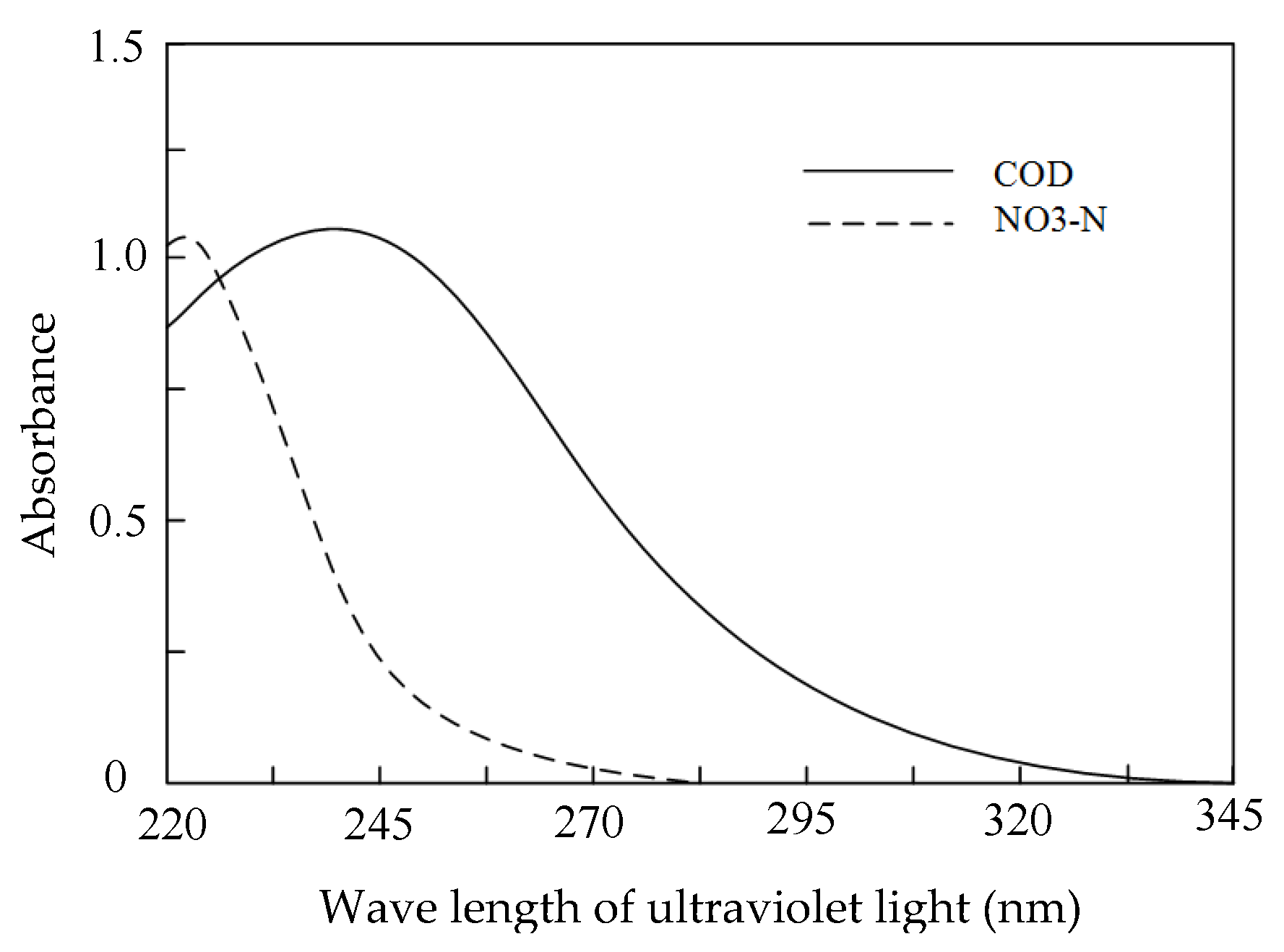
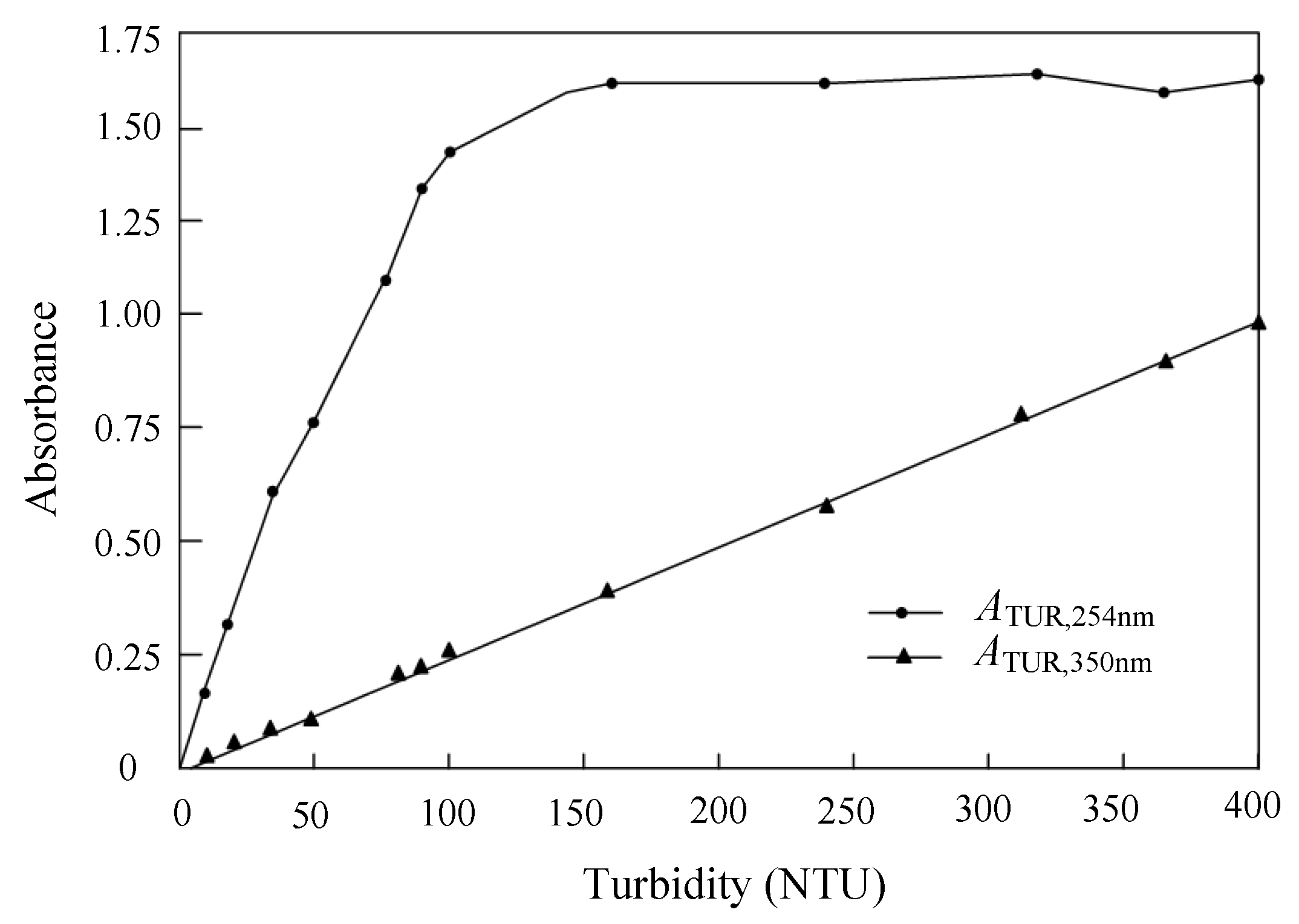
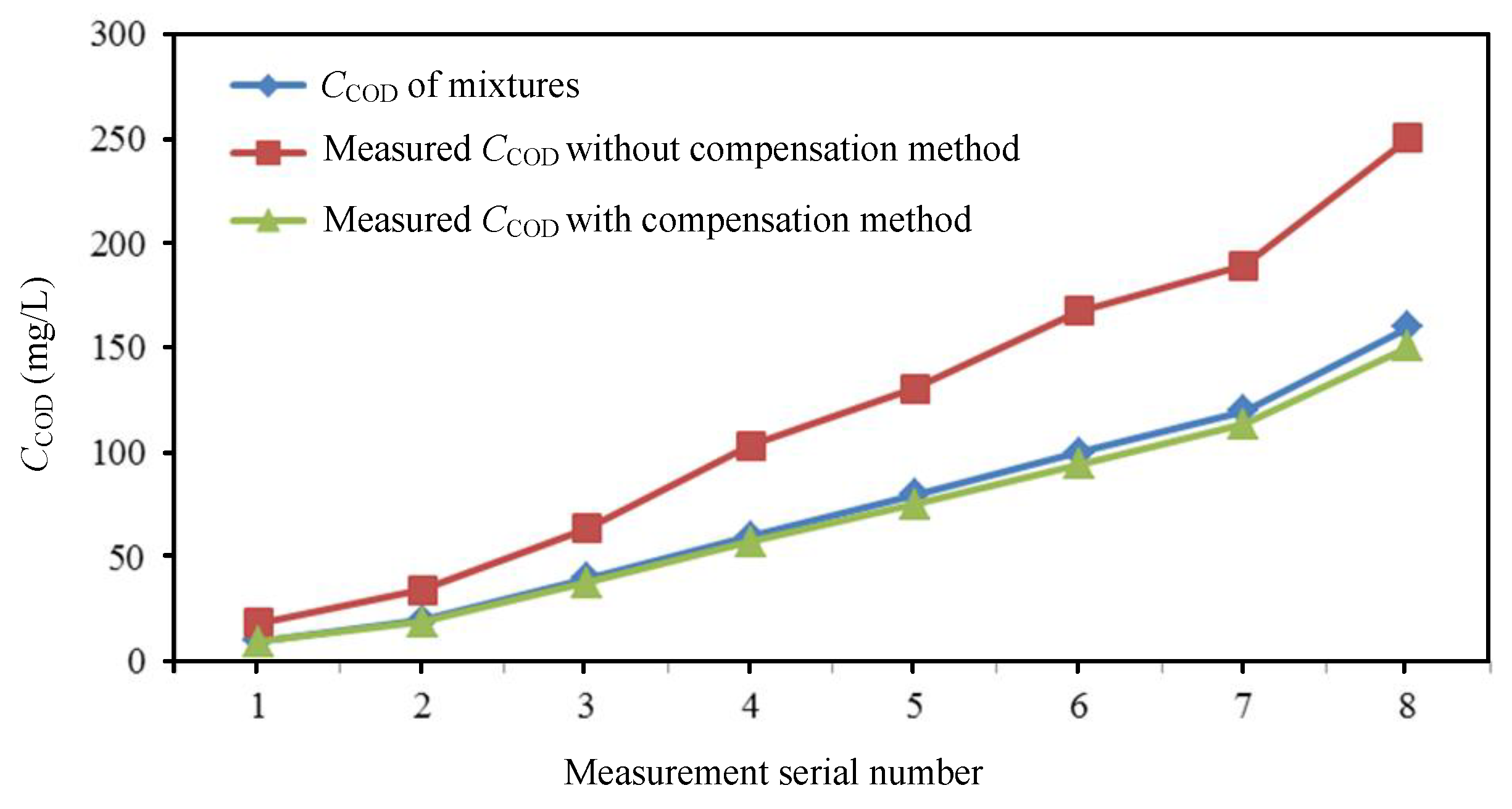
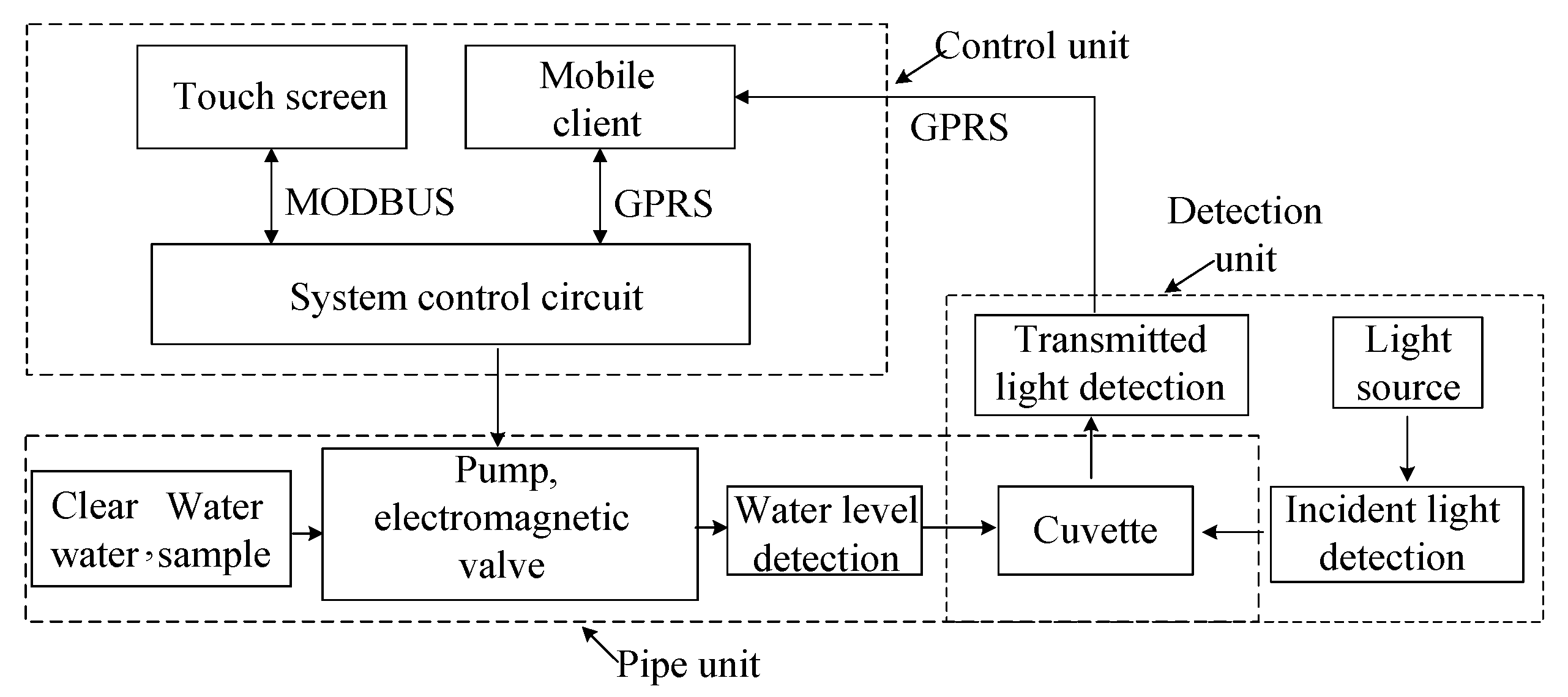
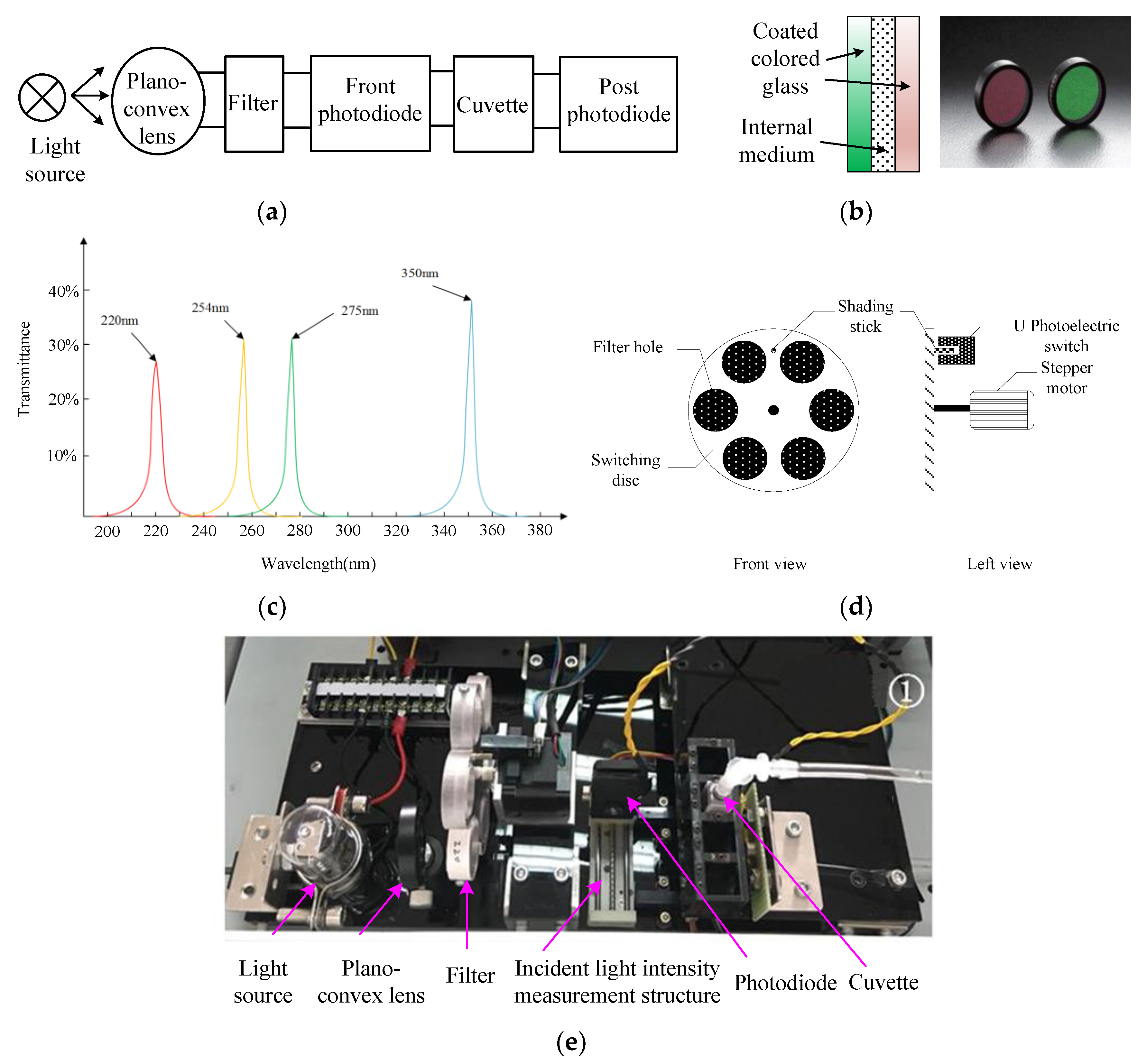
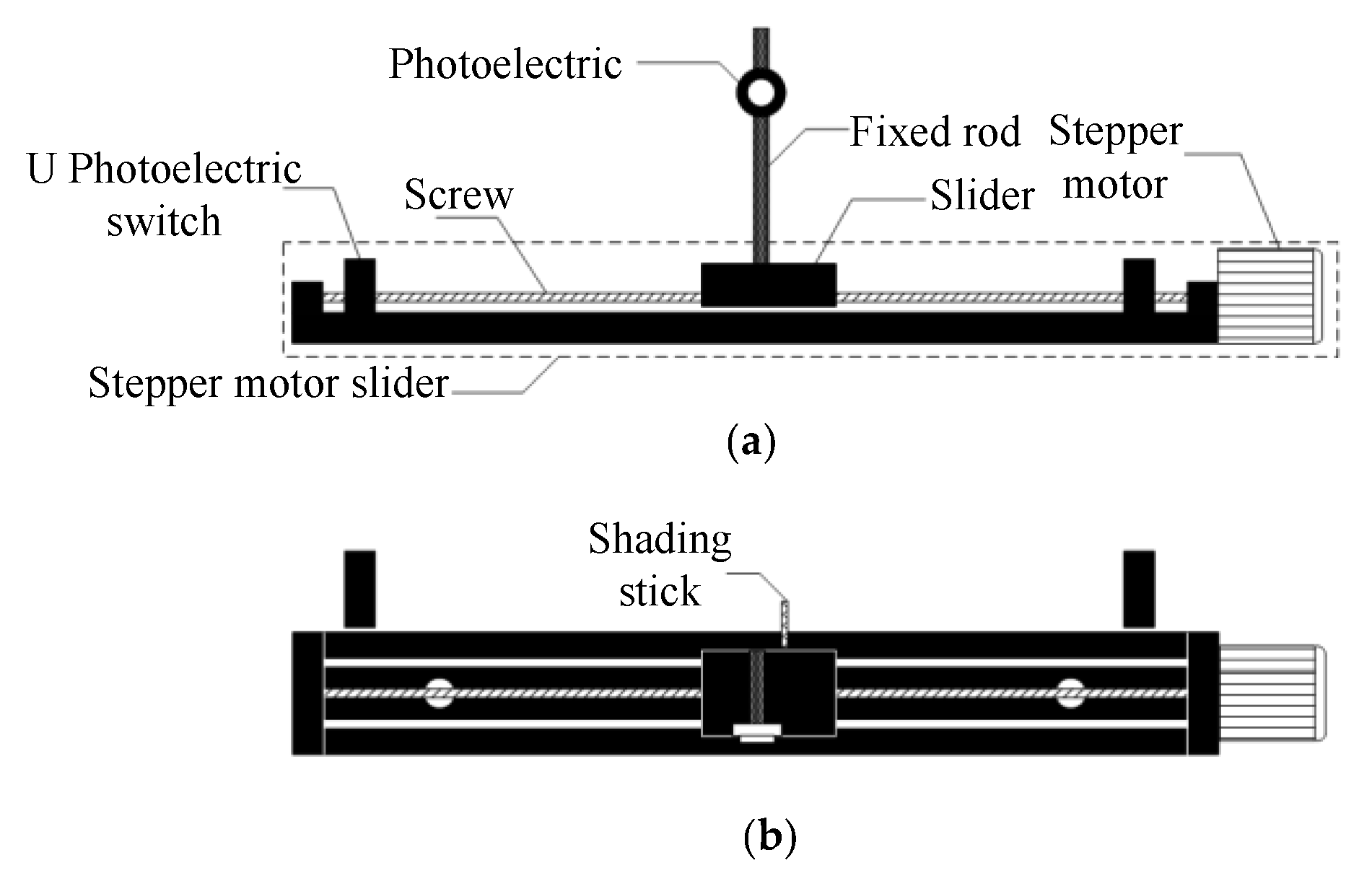
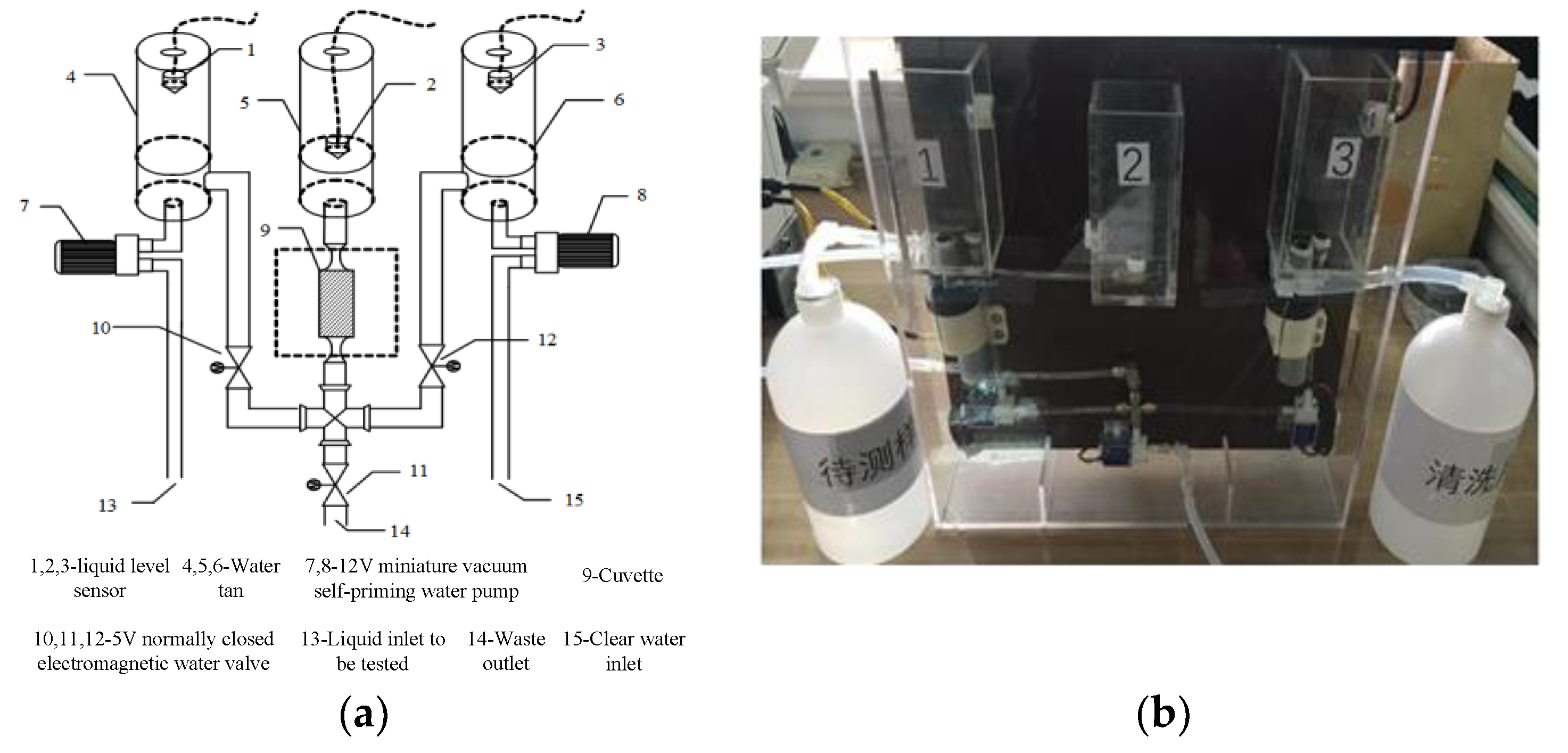
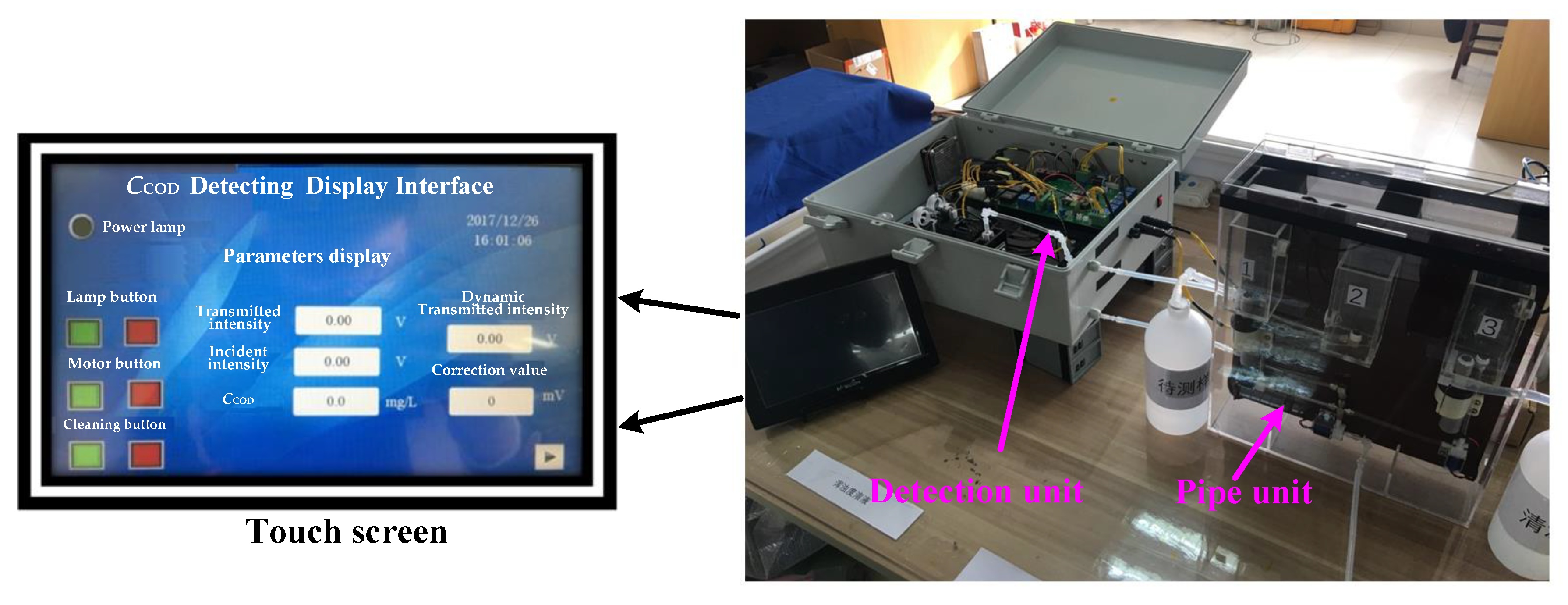
| Serial Number | Mixed Solution CCOD (mg/L) | Measured CCOD without Compensation (mg/L) | Relative Error without Compensation (%) | Measured CCOD with Compensation (mg/L) | Relative Error with Compensation (%) |
|---|---|---|---|---|---|
| 1 | 10 | 18.56 | 85.6 | 9.57 | −4.30 |
| 2 | 20 | 34.12 | 70.6 | 18.98 | −5.10 |
| 3 | 40 | 63.67 | 59.2 | 37.90 | −5.25 |
| 4 | 60 | 103.24 | 72.1 | 57.49 | −4.10 |
| 5 | 80 | 130.50 | 63.1 | 75.39 | −5.80 |
| 6 | 100 | 167.83 | 67.8 | 94.56 | −5.44 |
| 7 | 120 | 189.34 | 57.8 | 113.66 | −5.20 |
| 8 | 160 | 250.59 | 56.6 | 150.78 | −5.76 |
| Standard Solution Category | China National Standard Sample Number | Identification | Ingredients | Medium | Relative Expansion Uncertainty |
|---|---|---|---|---|---|
| COD | GBW (E) 081786 | 174960-3 | C8H5KO4 | H2O | U = 1% K = 2 |
| TOC | GSB 07-1967-2005 | 174860-3 | C8H5KO4 | H2O | U = 2% K = 2 |
| NO3–N | GSB 04-1772-2004 | 175059-3 | NO3- | H2O | U = 2% K = 2 |
| TURB | SGB-YQT01028H | 174760-3 | Formazine | H2O | U = 2% K = 2 |
| CCOD_T (mg/L) | ACOD,254nm | CCOD_T (mg/L) | ACOD,254nm |
|---|---|---|---|
| 50.00 | 0.262 | 300.00 | 1.581 |
| 100.00 | 0.513 | 350.00 | 1.769 |
| 150.00 | 0.764 | 400.00 | 2.201 |
| 200.00 | 1.015 | 450.00 | 2.271 |
| 250.00 | 1.267 | 500.00 | 2.522 |
| CCOD_T (mg/L) | Measured Results (mg/L) | Average Value (mg/L) | Relative Error (%) | |||
|---|---|---|---|---|---|---|
| No.1 | No.2 | No.3 | No.4 | |||
| 50.00 | 52.33 | 52.23 | 51.49 | 53.46 | 52.37 | 4.75 |
| 100.00 | 102.11 | 102.23 | 103.59 | 104.99 | 103.23 | 3.23 |
| 150.00 | 154.11 | 155.67 | 155.34 | 159.45 | 156.14 | 4.10 |
| 200.00 | 205.34 | 201.33 | 203.45 | 204.55 | 203.66 | 1.83 |
| 250.00 | 248.44 | 246.78 | 245.99 | 247.55 | 247.69 | −1.12 |
| 300.00 | 311.20 | 309.19 | 310.42 | 315.33 | 311.53 | 3.85 |
| 350.00 | 348.45 | 347.66 | 345.89 | 346.01 | 347.00 | −0.86 |
| 400.00 | 410.45 | 411.4 | 412.44 | 412.34 | 411.65 | 2.91 |
| 450.00 | 456.56 | 455.59 | 457.88 | 459.79 | 457.45 | 1.65 |
| 500.00 | 510.00 | 528.89 | 529.89 | 529.98 | 530.98 | 4.79 |
| CTOC_T (mg/L) | ATOC,254nm | CTOC_T (mg/L) | ATOC,254nm |
|---|---|---|---|
| 10.00 | 0.181 | 60.00 | 1.153 |
| 20.00 | 0.353 | 70.00 | 1.228 |
| 30.00 | 0.480 | 80.00 | 1.403 |
| 40.00 | 0.714 | 90.00 | 1.577 |
| 50.00 | 0.879 | 100.00 | 1.752 |
| CTOC_T (mg/L) | Measured Results (mg/L) | Average Value (mg/L) | Relative Error (%) | |||
|---|---|---|---|---|---|---|
| No.1 | No.2 | No.3 | No.4 | |||
| 10.00 | 10.58 | 10.39 | 10.43 | 10.35 | 10.44 | 4.37 |
| 20.00 | 21.10 | 21.05 | 20.89 | 20.99 | 21.00 | 4.89 |
| 30.00 | 29.79 | 29.90 | 30.02 | 29.87 | 29.89 | −3.50 |
| 40.00 | 41.89 | 42.05 | 41.78 | 41.86 | 41.90 | 4.73 |
| 50.00 | 52.90 | 52.49 | 52.06 | 51.99 | 52.36 | 4.72 |
| 60.00 | 58.04 | 57.88 | 57.89 | 57.90 | 57.93 | −3.45 |
| 70.00 | 67.30 | 67.50 | 67.34 | 67.20 | 67.34 | −3.81 |
| 80.00 | 83.80 | 83.90 | 84.10 | 84.10 | 84.98 | 4.97 |
| 90.00 | 89.00 | 88.70 | 88.67 | 88.60 | 88.74 | −1.40 |
| 100.00 | 104.90 | 104.48 | 103.59 | 104.10 | 104.27 | 4.27 |
| CNO3–N_T (mg/L) | ANO3–N,220nm | ANO3–N,275nm | CNO3–N_T (mg/L) | ANO3–N,220nm | ANO3–N,275nm |
|---|---|---|---|---|---|
| 1.00 | 0.017 | 0.001 | 6.00 | 0.085 | 0.001 |
| 2.00 | 0.028 | 0.000 | 7.00 | 0.098 | 0.001 |
| 3.00 | 0.044 | 0.001 | 8.00 | 0.110 | 0.000 |
| 4.00 | 0.055 | 0.000 | 9.00 | 0.123 | 0.000 |
| 5.00 | 0.070 | 0.000 | 10.00 | 0.140 | 0.002 |
| CNO3–N_T (mg/L) | Measured Results (mg/L) | Average Value (mg/L) | Relative Error (%) | |||
|---|---|---|---|---|---|---|
| No.1 | No.2 | No.3 | No.4 | |||
| 1.00 | 0.95 | 0.98 | 0.97 | 0.98 | 0.97 | −3.00 |
| 2.00 | 1.93 | 1.95 | 1.95 | 1.94 | 1.94 | −2.88 |
| 3.00 | 3.08 | 3.08 | 3.06 | 3.05 | 3.07 | 2.25 |
| 4.00 | 4.05 | 4.05 | 4.06 | 4.05 | 4.05 | 1.31 |
| 5.00 | 4.92 | 4.95 | 4.96 | 4.95 | 4.94 | −1.10 |
| 6.00 | 5.92 | 5.95 | 5.90 | 5.93 | 5.93 | −1.25 |
| 7.00 | 7.20 | 7.15 | 7.10 | 7.11 | 7.14 | 2.00 |
| 8.00 | 8.25 | 8.27 | 8.25 | 8.30 | 8.27 | 3.34 |
| 9.00 | 8.70 | 8.73 | 8.69 | 8.65 | 8.69 | −3.42 |
| 10.00 | 10.50 | 10.48 | 10.45 | 10.50 | 10.48 | 4.83 |
| CTUR_T (mg/L) | ATUR,350nm | CTUR_T (mg/L) | ATUR,350nm |
|---|---|---|---|
| 40.00 | 0.103 | 240.00 | 0.573 |
| 80.00 | 0.192 | 280.00 | 0.632 |
| 120.00 | 0.280 | 320.00 | 0.720 |
| 160.00 | 0.388 | 360.00 | 0.808 |
| 200.00 | 0.496 | 400.00 | 0.894 |
| CTUR_T (NTU) | Measured Results (NTU) | Average Value (NTU) | Relative Error (%) | |||
|---|---|---|---|---|---|---|
| No.1 | No.2 | No.3 | No.4 | |||
| 40.00 | 41.10 | 42.50 | 42.20 | 42.54 | 42.09 | 5.21 |
| 80.00 | 84.15 | 85.59 | 85.23 | 82.34 | 84.32 | 5.40 |
| 120.00 | 115.49 | 116.67 | 113.99 | 112.32 | 114.62 | −4.49 |
| 160.00 | 158.90 | 155.23 | 156.29 | 157.89 | 157.08 | −1.83 |
| 200.00 | 205.23 | 207.84 | 206.34 | 204.79 | 206.05 | 3.03 |
| 240.00 | 245.46 | 243.26 | 244.67 | 244.54 | 244.48 | 1.87 |
| 280.00 | 275.45 | 278.33 | 277.99 | 276.80 | 277.14 | −1.02 |
| 320.00 | 310.40 | 312.55 | 316.78 | 313.20 | 313.23 | 2.16 |
| 360.00 | 380.60 | 381.30 | 382.52 | 379.68 | 381.03 | 5.84 |
| 400.00 | 407.46 | 408.26 | 407.47 | 405.54 | 405.98 | 1.80 |
© 2019 by the authors. Licensee MDPI, Basel, Switzerland. This article is an open access article distributed under the terms and conditions of the Creative Commons Attribution (CC BY) license (http://creativecommons.org/licenses/by/4.0/).
Share and Cite
Wu, X.; Tong, R.; Wang, Y.; Mei, C.; Li, Q. Study on an Online Detection Method for Ground Water Quality and Instrument Design. Sensors 2019, 19, 2153. https://doi.org/10.3390/s19092153
Wu X, Tong R, Wang Y, Mei C, Li Q. Study on an Online Detection Method for Ground Water Quality and Instrument Design. Sensors. 2019; 19(9):2153. https://doi.org/10.3390/s19092153
Chicago/Turabian StyleWu, Xiushan, Renyuan Tong, Yanjie Wang, Congli Mei, and Qing Li. 2019. "Study on an Online Detection Method for Ground Water Quality and Instrument Design" Sensors 19, no. 9: 2153. https://doi.org/10.3390/s19092153





